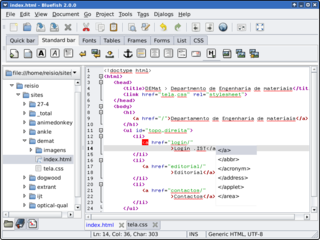In computing, an applet is any small application that performs one specific task that runs within the scope of a dedicated widget engine or a larger program, often as a plug-in. The term is frequently used to refer to a Java applet, a program written in the Java programming language that is designed to be placed on a web page. Applets are typical examples of transient and auxiliary applications that don't monopolize the user's attention. Applets are not full-featured application programs, and are intended to be easily accessible.
Dynamic HTML, or DHTML, is a term which was used by some browser vendors to describe the combination of HTML, style sheets and client-side scripts that enabled creation of interactive and animated documents. The application of DHTML was introduced by Microsoft with the release of Internet Explorer 4 in 1997.

The HyperText Markup Language or HTML is the standard markup language for documents designed to be displayed in a web browser. It can be assisted by technologies such as Cascading Style Sheets (CSS) and scripting languages such as JavaScript.

Java applets were small applications written in the Java programming language, or another programming language that compiles to Java bytecode, and delivered to users in the form of Java bytecode. The user launched the Java applet from a web page, and the applet was then executed within a Java virtual machine (JVM) in a process separate from the web browser itself. A Java applet could appear in a frame of the web page, a new application window, Sun's AppletViewer, or a stand-alone tool for testing applets.
Web design encompasses many different skills and disciplines in the production and maintenance of websites. The different areas of web design include web graphic design; user interface design ; authoring, including standardised code and proprietary software; user experience design ; and search engine optimization. Often many individuals will work in teams covering different aspects of the design process, although some designers will cover them all. The term "web design" is normally used to describe the design process relating to the front-end design of a website including writing markup. Web design partially overlaps web engineering in the broader scope of web development. Web designers are expected to have an awareness of usability and be up to date with web accessibility guidelines.
An HTML editor is a program for editing HTML, the markup of a web page. Although the HTML markup in a web page can be controlled with any text editor, specialized HTML editors can offer convenience and added functionality. For example, many HTML editors handle not only HTML, but also related technologies such as CSS, XML and JavaScript or ECMAScript. In some cases they also manage communication with remote web servers via FTP and WebDAV, and version control systems such as Subversion or Git. Many word processing, graphic design and page layout programs that are not dedicated to web design, such as Microsoft Word or Quark XPress, also have the ability to function as HTML editors.

Bluefish is a free and open-source software advanced text editor with a variety of tools for programming and website development. It supports coding languages including HTML, XHTML, CSS, XML, PHP, C, C++, JavaScript, Java, Go, Vala, Ada, D, SQL, Perl, ColdFusion, JSP, Python, Ruby, and shell. It is available for many platforms, including Linux, macOS and Windows, and can be used via integration with GNOME or run as a stand-alone application. Designed as a compromise between plain text editors and full programming IDEs, Bluefish is lightweight, fast and easy to learn, while providing many IDE features. It has been translated into 17 languages.
An HTML element is a type of HTML document component, one of several types of HTML nodes. The first used version of HTML was written by Tim Berners-Lee in 1993 and there have since been many versions of HTML. The most commonly used version is HTML 4.01, which became official standard in December 1999. An HTML document is composed of a tree of simple HTML nodes, such as text nodes, and HTML elements, which add semantics and formatting to parts of document. Each element can have HTML attributes specified. Elements can also have content, including other elements and text.
A lightweight markup language (LML), also termed a simple or humane markup language, is a markup language with simple, unobtrusive syntax. It is designed to be easy to write using any generic text editor and easy to read in its raw form. Lightweight markup languages are used in applications where it may be necessary to read the raw document as well as the final rendered output.
A user interface markup language is a markup language that renders and describes graphical user interfaces and controls. Many of these markup languages are dialects of XML and are dependent upon a pre-existing scripting language engine, usually a JavaScript engine, for rendering of controls and extra scriptability.
In HTML, div and span tags are elements used to define parts of a document, so that they are identifiable when a unique classification is necessary. Where other HTML elements such as p (paragraph), em (emphasis), and so on, accurately represent the semantics of the content, the additional use of span and div tags leads to better accessibility for readers and easier maintainability for authors. Where no existing HTML element is applicable, span and div can valuably represent parts of a document so that HTML attributes such as class, id, lang, or dir can be applied.
Run BASIC is a web application server, based on the Liberty BASIC version of the BASIC programming language.
ZK is an open-source Ajax Web application framework, written in Java, that enables creation of graphical user interfaces for Web applications with little required programming knowledge.

Cascading Style Sheets (CSS) is a style sheet language used for describing the presentation of a document written in a markup language such as HTML or XML. CSS is a cornerstone technology of the World Wide Web, alongside HTML and JavaScript.
Google Closure Tools is a set of tools to help developers build rich web applications with JavaScript. It was developed by Google for use in their web applications such as Gmail, Google Docs and Google Maps.
HTML attributes are special words used inside the opening tag to control the element's behaviour. HTML attributes are a modifier of an HTML element type. An attribute either modifies the default functionality of an element type or provides functionality to certain element types unable to function correctly without them. In HTML syntax, an attribute is added to an HTML start tag.

Google Chrome Experiments is an online showroom of web browser based experiments, interactive programs, and artistic projects. Launched on March 1, 2009, Google Chrome Experiments is an official Google website that was originally meant to test the limits of JavaScript and the Google Chrome browser's performance and abilities. As the project progressed, it took the role of showcasing and experimenting latest open-source web-based technologies, such as JavaScript, HTML5, WebGL, Canvas, SVG, CSS, and some others. All the projects on Chrome experiments are user submitted and are made using open source technologies. As of February 24, 2015, there were 1,000 different Chrome projects posted on the website.
Front-end web development is the development of the graphical user interface of a website, through the use of HTML, CSS, and JavaScript, so that users can view and interact with that website.

Paul S. Wang is a Chinese-American computer scientist, researcher, author, consultant, and academic. He is Professor Emeritus of Computer Science at Kent State University.





